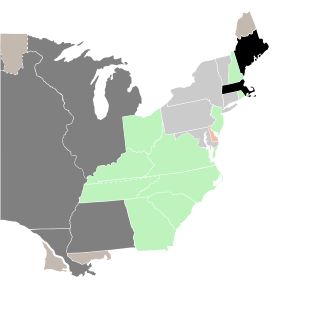Top Qs
Timeline
Chat
Perspective
1810–11 United States Senate elections
From Wikipedia, the free encyclopedia
Remove ads
The 1810–11 United States Senate elections were held on various dates in various states. As these U.S. Senate elections were prior to the ratification of the Seventeenth Amendment in 1913, senators were chosen by state legislatures. Senators were elected over a wide range of time throughout 1810 and 1811, and a seat may have been filled months late or remained vacant due to legislative deadlock.[1] In these elections, terms were up for the senators in Class 2.
The Democratic-Republican Party maintained their Senate majority. The minority Federalists had gone into the elections with such a small share of Senate seats (8 out of 34, or 23.5%) that, had they won all of the elections, they would still not have reached a majority.
Remove ads
Change in composition
Summarize
Perspective
Senate Composition in 1809
Democratic-Republicans: 28 seats Federalists: 6 seats
Senate Composition in 1811
Democratic-Republicans: 30 seats Federalists: 6 seats
Key Changes
Democratic-Republicans: The Democratic-Republicans gained 2 seats, increasing their majority from 28 to 30 seats. Federalists: The number of Fedethe ralist seats remained unchanged at 6.
Context
The Democratic-Republican Party continued to dominate the Senate, reflecting the broader political landscape of the era. The period was marked by the lead-up to the War of 1812, with growing tensions between the United States and Great Britain influencing political discourse and legislative priorities.[2]
| DR7 | DR6 | DR5 | DR4 | DR3 | DR2 | DR1 | |||
| DR8 | DR9 | DR10 | DR11 | DR12 | DR13 | DR14 | DR15 | DR16 | DR17 |
| Majority → | DR18 Ga. Ran | ||||||||
| F8 Mass. Ran |
DR26 Va. Ran |
DR25 Tenn. Ran |
DR24 S.C. Retired |
DR23 R.I. Unknown |
DR22 N.C. Ran |
DR21 N.J. Ran |
DR20 N.H. Ran |
DR19 Ky. Retired | |
| F7 Del. Ran |
F6 | F5 | F4 | F3 | F2 | F1 | |||
Result of the regular elections
| DR7 | DR6 | DR5 | DR4 | DR3 | DR2 | DR1 | |||
| DR8 | DR9 | DR10 | DR11 | DR12 | DR13 | DR14 | DR15 | DR16 | DR17 |
| Majority → | DR18 Ga. Re-elected | ||||||||
| V1 Mass. F Loss |
DR26 Va. Re-elected |
DR25 Tenn. Re-elected |
DR24 S.C. Hold |
DR23 R.I. Hold |
DR22 N.C. Re-elected |
DR21 N.J. Re-elected |
DR20 N.H. Re-elected |
DR19 Ky. Hold | |
| F7 Del. Re-elected |
F6 | F5 | F4 | F3 | F2 | F1 | |||
Remove ads
Race summaries
Summarize
Perspective
Except if/when noted, number following candidates is whole number votes.
Special elections during the 11th Congress
In these special elections, the winners were seated during 1810 or before March 4, 1811; ordered by election date.
Races leading to the 12th Congress
In these regular elections, the winner was seated on March 4, 1811 (except where noted due to late election); ordered by state.
All of the elections involved the Class 2 seats.
Special elections during the 12th Congress
In these special elections, the winners were seated in 1811 after March 4; ordered by election date.
Remove ads
Connecticut (special)
This section needs expansion. You can help by adding to it. (October 2019) |
Delaware
Delaware (regular)
This section needs expansion. You can help by adding to it. (October 2019) |
Delaware (special)
This section needs expansion. You can help by adding to it. (October 2019) |
Georgia
This section needs expansion. You can help by adding to it. (October 2019) |
Kentucky
This section needs expansion. You can help by adding to it. (October 2019) |
Massachusetts
Massachusetts (regular)
This section needs expansion. You can help by adding to it. (October 2019) |
Massachusetts (special)
This section needs expansion. You can help by adding to it. (October 2019) |
New Hampshire
New Hampshire (regular)
This section needs expansion. You can help by adding to it. (October 2019) |
New Hampshire (special)
This section needs expansion. You can help by adding to it. (October 2019) |
New Jersey
This section needs expansion. You can help by adding to it. (October 2019) |
North Carolina
This section needs expansion. You can help by adding to it. (October 2019) |
Ohio (special)
This section needs expansion. You can help by adding to it. (October 2019) |
Rhode Island
Rhode Island (regular)
This section needs expansion. You can help by adding to it. (October 2019) |
Rhode Island (special)
This section needs expansion. You can help by adding to it. (October 2019) |
South Carolina
South Carolina (regular)
This section needs expansion. You can help by adding to it. (October 2019) |
South Carolina (special)
This section needs expansion. You can help by adding to it. (October 2019) |
Tennessee
Tennessee (regular)
This section needs expansion. You can help by adding to it. (October 2019) |
Tennessee (special)
This section needs expansion. You can help by adding to it. (October 2019) |
Virginia
This section needs expansion. You can help by adding to it. (October 2019) |
See also
Notes
- Charles Cutts (NH) has conflicting accounts of whether he was a Democratic-Republican or a Federalist.
References
External links
Wikiwand - on
Seamless Wikipedia browsing. On steroids.
Remove ads

